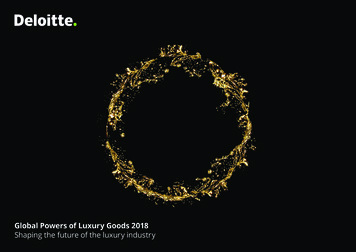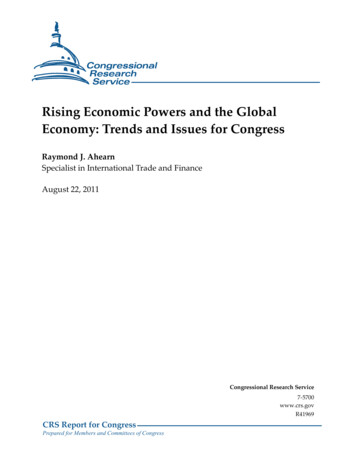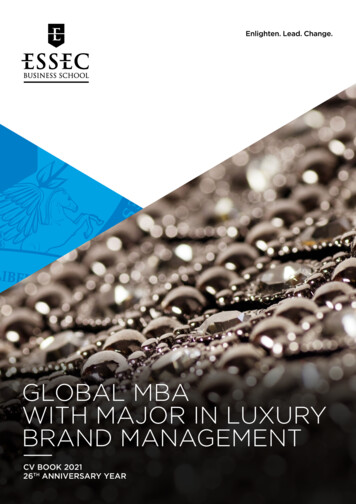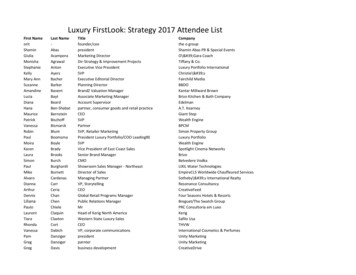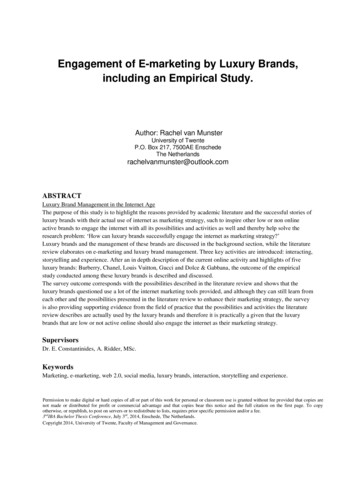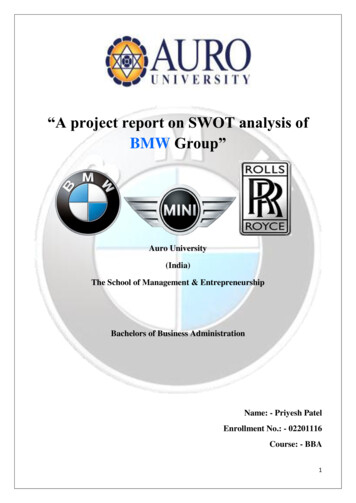
Transcription
Global Powers ofLuxury Goods 2015Engaging the futureluxury consumer
ContentsIntroduction1Global economic outlook2Engaging the future luxury consumer8Global Powers of Luxury Goods Top 10014Top 100 highlights20Top 1022Geographic analysis24Product sector analysis30Newcomers34Fastest 2036M&A activity38Study methodology and data sources45Contacts46Global Powers of Luxury Goods 20154
Deloitte Touche Tohmatsu Limited (DTTL) is pleased topresent the 2nd annual Global Powers of Luxury Goods.This report identifies the 100 largest luxury goodscompanies around the world based on publicly availabledata for the fiscal year 2013 (encompassing companies’fiscal years ended through June 2014).The report also provides an outlook on the globaleconomy; an analysis of market capitalization in theluxury goods industry; a look at merger & acquisitionactivity in the industry; and a discussion on engagingthe future luxury consumer.Global Powers of Luxury Goods 20151
Global economic outlookThe global economy in early 2015 offers luxury purveyors bothcause for celebration and concern. On the celebratory side,some key markets are showing signs of greater strength. The USeconomy is clearly performing better than in recent years, withemployment growth up considerably and asset prices havingstrengthened substantially. In Europe and Japan, more aggressivemonetary policies are boosting growth as well as asset prices. Onthe other hand, China’s economy continues to decelerate, evenas the government takes steps to boost credit market activity. Intwo of the three other BRICs, Russia and Brazil, circumstances haveconspired to create a weak economic environment. In addition, theuncertainty of currency volatility is making it difficult for companiesto plan for the future. What follows is a look at the global economyand the potential impact on luxury goods companies.Currencies US dollarOne of the big stories in 2014 and early2015 has been the sharp rise in thevalue of the U.S. dollar against most other major currencies. Therewere several reasons for this. Among them were the decline inthe price of oil; faster economic growth in the U.S.; expectationsof higher U.S. interest rates; and weak growth combined withmore aggressive monetary policy in Europe, China, and Japan. Therising dollar has many effects. First, it is disinflationary in the U.S.by reducing import prices. This will provide the Federal Reservewith more time before it must raise short term interest rates.Second, a rising dollar is inflationary for everyone else. That willbe good for Europe and Japan, where inflation is way too low. ItGlobal Powers of Luxury Goods 2015will be a problem in many emerging markets. Indeed several haveraised short term interest rates in order to stabilize their currenciesand fight inflation, leading to slower growth. Third, a rising dollarcould be problematic for companies in emerging countries that havedollar-denominated debts. The volume of such debt has quadrupledin the last seven years. Going forward, while it is nearly impossible toaccurately predict exchange rates, it does seem likely that the dollarwill continue to face upward pressures, at least in 2015. EuroThe introduction of a far moreaggressive monetary policy by theEuropean Central Bank (ECB) has put downward pressure on theeuro. Bond yields in Europe have been suppressed and investors,seeking yield, have sold euros and purchased U.S. dollars. Theeffect of a declining euro has been to boost the competitivenessof European exports. This, in turn, has caused investors to push upequity prices of European companies. Moreover, the cheaper euro,by raising import prices, is helping the ECB to fight deflation. Swiss francIt is rare that Switzerland tops the world’seconomic news, but that was certainlythe case at the start of 2015. First, a little background: Three yearsago the Swiss National Bank (SNB), which is Switzerland’s centralbank, imposed a cap on the value of the Swiss franc in order toprevent a sharp rise that would kill Swiss exports. Prior to that,there had been considerable upward pressure on the franc withglobal investors seeing it as a safe-haven asset at a time of turmoilin Europe. The cap, at 1.2 francs per euro, required that the SNBcontinually sell francs (purchase euros) in order prevent a rise inthe value of the franc. Yet the problem with doing so is that it canultimately lead either to consumer price inflation or asset priceinflation by increasing the supply of francs. While neither of thesehappened, the SNB worried that the situation would becomeunsustainable when the ECB started to implement quantitativeeasing (QE), which it did in March 2015. The SNB surmised thatsuch action would probably mean more downward pressure onthe euro, thereby necessitating more euro purchases by the SNBand more Swiss money supply growth. Therefore, in anticipation ofQE, the SNB in January removed the cap on the value of the franc,stunning global financial markets. Immediately, the value of thefranc soared as much as 40 percent against the euro before settlingin at a gain of roughly 15 percent. To ease the pain, the SNB cutits benchmark interest rates. Moreover, the safe haven nature ofSwitzerland has rendered bond yields negative.For Switzerland, the rise in the value of the franc means lesscompetitiveness for Swiss export-oriented companies. It will meanhigher prices paid by customers and/or lower profit margins forSwiss companies. The result will be slower economic growththan would otherwise have been the case. It will also boostthe competitiveness of companies based in the Eurozone thatcompete with Swiss companies. For Swiss consumers, the rise inthe value of their currency means greater purchasing power asimports become cheaper.When it comes to luxury goods, the situation is a bit less clear.Consumers of luxury products are not necessarily price sensitive.Theoretically, it could be the case that a Swiss product with strongbrand equity will not see a decline in sales volume even if prices2
paid by foreigners rise. On the other hand, we don’t live in atheoretical world. Price sensitivity varies depending on whethera product is high end or aspirational, whether or not its brand isconsidered unique, and the nature of markets in which it is sold.Moreover, it is difficult to identify the impact of exchange ratemovements on price when other factors play a significant role.These can include the competitive situation and the economicstrength of export markets. For example, the corruption crackdownin China has reduced demand for high end luxury products, thuscausing a drop in prices.Oil pricesAs of this writing, the global price of oil has declined more than50 percent from where it was in the first half of 2014. Oil hasfallen due to weak global demand combined with a considerableincrease in oil production in the U.S., Canada, Iraq, and Libya. Yetthe U.S. is the main story, with oil production through “fracking”in North Dakota and Texas having transformed the global industry.The other big part of the story is the decision by Saudi Arabia notto cut production in order to boost prices. Rather, the Saudis arecontent to allow the price to sink in the hope that they will gainmarket share at the expense of frackers.The drop in the price of oil is having a considerable impacton the global economy. It is creating disinflationary pressures,especially in developed markets such as the U.S., Europe, andJapan; it is boosting consumer purchasing power in oil consumingnations such as Japan, India, the U.S., and much of Europe andcontributing to faster economic growth than would otherwise bethe case; and it is wreaking havoc for oil exporters such as Russia,Iran, Venezuela, and Nigeria. Most importantly it has contributedto the stunning rise in the value of the U.S. dollar. Oil exportersare paid in dollars and then re-cycle those dollars by purchasinggoods or assets from the rest of the world. With a lower oil price,the supply of dollars available for such purchases has declined. Thispaucity of dollars has caused the price of dollars to rise.What can we expect going forward? In the short term, it is likelythat the price of oil will either stabilize or fall further—all in thecontext of increased volatility. There is a considerable amountof new oil production already in the pipeline in the U.S. that isexpected to come on line in 2015, and crude inventories continueto pile up. Longer term, however, a low price is likely to retardinvestment in fracking. Indeed we’re already seeing a cutback indrilling permits and a drop in oil company capital expenditures. Areduction in U.S. production could, therefore, happen right whenglobal demand starts to pick up speed. If this happens, the pricewill surely rebound, perhaps in the next one to two years. A risingprice will be inflationary for consuming nations, will put pressureon external debt service for consuming nations, and will probablyforce tighter monetary policy at least in the U.S. For oil exporters, itwould be beneficial—especially for such countries as Russia, Iran,Venezuela, and Mexico.Major marketsChinaChina’s economy has sloweddown and continues to showconsiderable signs of weaknessdespite government effortsto reverse the slowdown. TheChinese economy grew 7.4percent in 2014, the slowest rate since 1990. The governmentexpects growth of only 7.0 percent in 2015. Lower growth couldmean an inability to absorb workers migrating from rural to urbanareas. The result would be high unemployment and social unrest.And, if the workers didn’t migrate, China wouldn’t grow since therewould be zero productivity gains that come from switching workersfrom farms to factories. Thus, China can ill afford to grow muchmore slowly.Why is China decelerating? First, export markets such as Europehave been dormant. Even the U.S. market isn’t what it used tobe for China. Plus, China’s wages and currency have increasedin recent years, thereby reducing the competitiveness of Chineseexports. Indeed with the renminbi relatively steady lately againstthe U.S. dollar, it has thus risen considerably against the euro andyen. Consequently, Chinese exports to Europe and Japan havebeen weakened. Indeed some manufacturing capacity has movedoutside of China. Companies are looking elsewhere to producegoods for export. Basic assembly is moving from China to Vietnam,Indonesia, and elsewhere.Second, the government has attempted to limit the growthof the shadow banking system. Lending outside traditionalGlobal Powers of Luxury Goods 20153
banking channels has resulted in excess investment in property,infrastructure, and heavy industry. The result is a growing volumeof non-performing assets which threatens the stability of thefinancial system. Indeed the government has recently estimatedthat, in the past five years, 6.8 trillion in investment has beenwasted. Yet efforts to limit this activity have contributed to theslowdown in growth. The government is torn between a desireto limit financial risk and a desire to avoid a sharp slowdown. Ithas taken measures to limit the growth of shadow banking while,at the same time, attempted to stimulate more traditional formsof credit through repeated easing of monetary policy. Indeedinterest rates have been cut and the required reserve ratio ofbanks has been reduced. The problem is that, with considerableexcess capacity in property and industry, it is not clear that easiermonetary policy will necessarily lead to more credit market activity.Moreover, it is not clear if such an increase would be beneficial.It could exacerbate the problem of excess capacity, exacerbatewholesale price deflation, and ultimately lead to financial losses.One side effect of the slowdown in economic growth has beendeceleration of retail spending. Moreover, the government’scrackdown on corruption has caused a drop in the traditionalgiving of luxury gifts, thus exacerbating the slowdown in retailsales growth. In addition, China has lately seen considerableoutflows of capital. Wealthy individuals have been moving moneyout of the country, often into high end property markets in suchcities as Sydney, London, New York, Vancouver, and Los Angelesto name a few. This has put downward pressure on the Chinesecurrency, compelling the central bank to sell foreign currencyreserves in order to prevent a sharper decline.Global Powers of Luxury Goods 2015USAEuropeThe U.S. economy hasaccelerated and will likely growfaster in 2015 than at any timesince 2005. While there are signsof strength, there have also been signs of weakness in early 2015.In part this may reflect bad weather in much of the country. But itmay also reflect the impact of a weak overseas economy as wellas the negative effect of a high valued dollar. The most importantpositive sign, however, is a very strong job market. Also, there areindications that a pickup in business investment is imminent. Themajor weak component of the U.S. economy is housing. Datahave bounced around in the past year due to higher mortgageinterest rates, higher house prices, and the fact that first-timebuyers are often plagued by student debt. However, the mediumterm outlook for housing is good given that prices appear to bestabilizing, mortgage rates are down, job growth is strong, andthere is considerable pent-up demand. A disproportionate share ofthe activity is now in multi-unit housing rather than single familyhousing. And, in some big cities, prices at the upper end have beenboosted by inflows of Chinese money.After a prolonged periodof disappointing economicperformance, the Eurozoneeconomy is starting toshow some early signs ofimprovement. These includestronger job growth, risingretail sales, improved manufacturing performance, and someimprovement in credit market conditions. Still, more is needed and,in some parts of Europe, growth remains weak. Moreover, whiledeflation has been avoided, inflation remains too low. The principalproblem has been weakness in credit markets resulting in a paucityof business investment. The end result, until recently, has beenweak hiring and high unemployment. Credit market weaknessstems from several factors. These include weak banks that arestruggling to recapitalize by selling risky assets and avoiding newones, high risk spreads in Europe’s periphery due to fears aboutsovereign risk, and the fear of deflation. Despite a moderatelyaggressive monetary policy, which has led to growth of the broadmoney supply, bank credit to the private sector continues todecline, especially in Europe’s peripheral countries.Due in part to the dramatic decline in oil prices, inflation remainswell below the Federal Reserve’s target of 2.0 percent. As such, itis likely that the Fed will wait at least until the end of 2015 beforeraising short term interest rates for the first time in eight years.Plus, low inflation and lower energy prices are helping to boostconsumer purchasing power. In addition, unlike in the recentpast, there is no fiscal consolidation taking place. Due to a strongeconomy, the budget deficit has fallen dramatically, thereby nearlyeliminating the political pressure to do something about the deficit.The absence of spending cuts and tax increases removes a factorthat held back growth in 2012-13.To counter the problems in credit markets, the ECB has latelyengaged in a far more aggressive monetary policy. This entailsvery low interest rates, direct low-interest loans to banks on thecondition that the money is then loaned to the private sector, andmost importantly, purchases of government bonds—better knownas quantitative easing. The early signs are good. Yet quantitativeeasing alone may not be sufficient to restore strong growth. Europestill needs an easier fiscal policy, more economic restructuring withinkey countries, and more financial integration within the Eurozone.4
JapanJapan went into recession in 2014following a big tax increase, withdeclining consumer spending andbusiness investment. This was notmeant to be. When Shinzo Abetook office roughly two years ago,he offered a radical departure inpolicy characterized by the three“arrows” of “Abenomics.” These were fiscal stimulus, aggressivemonetary policy, and structural reform (basically deregulationand free trade). Of the three arrows, only one was implemented.This was monetary policy in which the Bank of Japan engaged inunlimited quantitative easing with the goal of ultimately achieving2.0 percent inflation. The effect of this policy was to suppress theyen, boost equity prices, boost inflation, and suppress real interestrates. Initially it had a positive impact on growth. Then, thingschanged. Wages failed to respond and real consumer purchasingpower declined—having a negative impact on consumer spending.The rest of the world failed to cooperate and weak externaldemand hurt exports. But the worst problem was implementationof a massive tax increase in April 2014, a policy that had alreadybeen in the pipeline when Abe took office. This had a devastatingimpact and led to the recent recession.The good news is that, by early 2015, the Japanese economywas out of recession and growth was starting to accelerate.Unemployment was down, business sentiment was up, and assetprices were rising, largely a result of the aggressive monetarypolicy of the central bank. On the other hand, consumer spendingremains weak and, despite the much lower value of the yen, theindustrial side of the Japanese economy has yet to experience asignificant rebound. Going forward, it appears likely that Japan willexperience modest growth. Yet the major uncertainty is the degreeGlobal Powers of Luxury Goods 2015to which the government will embark on significant reforms, asoriginally promised. Meanwhile Japan negotiates with the U.S.over the Trans-Pacific Partnership (TPP), an agreement aimed atliberalizing cross-border flows of goods and capital in the PacificRim region. If an agreement is reached, it could play a major role incompelling the government to liberalize various domestic industries,thus helping to boost productivity and spur faster growth.BrazilAs of early 2015, Brazil’s economy is inrecession. This is due to a sharp dropin commodity prices (due to China’sslowdown); a central bank policy of highinterest rates to fight inflation and tostabilize the currency; and business lack ofconfidence due to a government policy ofhigh regulation and protectionism. In addition, Brazil has sufferedfrom the rise in the U.S. dollar, which is one of the reasons that thecentral bank has been compelled to tighten monetary policy. Theelection in late 2014 resulted in a second term for President DilmaRousseff. Although she has since appointed a very market-orientedFinance Minister, there remains uncertainty as to whether shewill gain legislative approval to implement the fiscal austerity andeconomic reforms she promises. Among the policies that investorswant are a reduction in government social spending and subsidies(in order to cut the deficit and free up resources for investmentin infrastructure); deregulation of labor and product markets; andfreer trade. As for trade, Brazil remains a relatively protectionisteconomy. Trade is a much smaller share of GDP than is the casein China or India. The range of reform ideas is meant to boostproductivity and improve Brazil’s competitiveness. This is importantas domestic demand is not likely to be a major source of growth inthe near future. Consumer debt is already quite high, so consumerspending will necessarily be constrained. Until now, Rousseff’smajor platform has been an effort to boost the spending power ofthe poor through government transfers.IndiaIndia had a highly significant election in2014, resulting in the election of NarendraModi as Prime Minister. For the first timein more than 30 years, a Prime Minister’sparty has a majority in the Parliament,thus boosting prospects for enactingreform legislation. Yet in his first six months in office, not muchreform legislation was proposed, thus disappointing supporterswho were euphoric following Modi’s victory. They are hoping hewill deregulate industry and labor markets, reduce costly subsidies,boost infrastructure investment, negotiate freer trade, and easerestrictions on foreign investment. If he does these things, India’sgrowth outlook will likely improve dramatically. Meanwhile, growthis recovering from its doldrums but remains below potential. Thecentral bank has managed to reduce inflationary expectations,which should have a positive impact on growth. Plus, lower oilprices are having a positive impact both on inflation and growth.RussiaRussia’s economyis in bad shape.Following the crisisin Ukraine and theimplementation ofsanctions, there was massive capital flight from Russia resultingin a sharp drop in the currency. This, in turn, led the central bankto severely raise interest rates several times. The result was thatinvestment dried up, including foreign investment. Moreover, thedeclining global price of oil also contributed to downward pressureon the currency and concerns about the ability of Russian debtorsto service their external debts. The sanctions that have beenimposed mean that some big Russian companies will have troublerolling over foreign debts due to limited access to foreign financial5
markets. Already risk spreads have increased dramatically. Someenergy companies will lack access to technologies that are neededto tap into Arctic reserves. This means that oil production is likelyto decline absent an end to sanctions. By early 2015, the centralbank had stopped intervening in currency markets and had startedto cut interest rates. With oil prices stabilizing, the ruble hasrebounded somewhat, but inflation remains high and investmentis very weak. When oil ultimately rebounds, this will help Russia.Yet in the absence of an easing of sanctions, it will be difficult forRussia to return to strong economic growth.South AfricaEconomic growth has decelerated steadilyover the last few years and is now onlyslightly above 1 percent per year. Inflationhas been high, but has come down due tolower energy prices. The country has beenhurt by labor unrest, declining commodity prices, shortages ofelectricity, and under-investment. On the other hand, the declinein the price of oil should boost consumer spending power in 2015.Still, the currency (rand) has been under pressure, thus contributingto inflation and limiting the flexibility of the central bank. Whilegrowth is expected to pick up in 2015 and beyond, most analystssee South Africa as having limited potential. Growth is expected torecover to a level of 3 to 4 percent, far below that of many otherAfrican economies. However, due to South Africa’s sophisticatedbusiness environment, it is expected to remain a major center ofbusiness and finance for the continent.Global Powers of Luxury Goods 2015ConclusionThe economic climate for luxury goods companies is, on balance,positive, but there are risks and problems nonetheless. On thepositive side, the economies of the U.S., Europe, and Japan allappear to be on the rebound. Asset prices, including propertyprices, have done well, thus boosting the purchasing power ofupscale consumers. On the negative side, economic growth inthree of the four BRIC economies has either stalled or decelerated,the exception being India. Moreover, currency market volatilityhas thrown a monkey wrench into the best laid plans of manycompanies. Among the risks going forward are the possibilityof a rise in energy prices, a drop in asset prices, and potentialgeopolitical shocks in such places as the Middle East and the SouthChina Sea. Overall, however, luxury goods companies should bepleased that, after many years of stagnant growth, the globaleconomy is mostly on a positive path.6
Global Powers of Luxury Goods 20157
Engaging the future luxury consumerThe ever-sophisticated luxury consumer is increasingly digitallysavvy, time-sensitive, and socially aware. To engage such aconsumer the luxury industry has three significant challenges. Thefirst is technology: 2015 so far has very much been a “smart” yearin the luxury sector, and the sector needs to continue to forge astrong relationship with an ever-increasing array of technologies.Second, the rapidly evolving consumer profile makes it critical forcompanies to understand the changing desires, buying behaviorsand channels of luxury consumers. Underpinning both of thesefactors is the luxury brand’s commitment to its history, provenance,and community. Supporting a shared history by giving back tothe community can strengthen brand equity and create long-termstrategic and financial reward for the business.Why technology matters in luxuryThe relationship between digital and luxury can no longer beignored. Technology will continue to influence the entire valuechain within the sector.EvaluationThe luxury industry as a digital “latecomer”: It is a popular—butin many ways unfair—criticism to suggest that luxury brands havebeen too slow to include digital, and specifically e-commerce, intheir business. This slower adaptation has its basis in the need forluxury brands to first and foremost protect brand heritage. Thislegitimate concern about diluting the brand’s uniqueness andexclusivity in the broadly accessible online world requires brands tomove cautiously to ensure sustainable, long-term value creation.According to Deloitte’s 2014 Swiss Watch report,1 executives fromthat industry identified reputational risk from social media as oneof the highest risks in online marketing and distribution.Global Powers of Luxury Goods 2015In spite of these challenges, however, many brands are showinggreat innovation and are embracing the potential for digitaltechnology to reach new audiences, enhance brand awareness,and establish a broader geographic reach.No longer just about digital marketing: For technology to bemost effective in the luxury space, companies must integrateit throughout the entire value chain and not just limit it to themarketing function. This is particularly relevant given that today’smulti-faceted luxury consumer can offer multiple opportunities forengagement. He or she is younger, healthier, driven, sophisticated,exacting, digitally-savvy, experience-driven, service-focused,time-pressed, prudent, and environmentally aware. Well-placedtechnology investments at three main value chain touch-pointsare likeliest to positively affect return on investment and long-termvalue creation.1. Product development: Innovation in product developmentenhances existing products and creates new ways to fusecraftsmanship with modernity. Kering’s Materials Innovation Lab2and Biocouture3 are just two examples of firms investing heavilyin R&D with regards to raw materials and fabric manufacturingprocesses. Grace Choi’s 3D make-up printer4 unveiled earlierthis year and Ralph Lauren’s “Polo Tech” shirt5 are excitingexamples of luxury brands incorporating technology into productdevelopment.2. CRM systems: Effectively managing the way in which detailedconsumer information is captured and then turning it to abrand’s advantage will enhance the competitive positioning ofluxury groups and brands. According to research conducted byExane BNP and ContactLab, Burberry excels in their e-commerceStrategic Reach (number of countries, languages, productcategories offered online), and digital customer experience(website navigation and the online purchasing process).6 By usingsmart analytics, Burberry collects information on its customers’shopping habits and tailors their in-store and online experiences.73. Enhanced customer experience: Luxury brands that usetechnology to make their consumers’ lives easier and makeinteractions more engaging will rapidly build stronger brandvalue and broaden their market footprint. Moreover, given theincreasing number of devices used by consumers, all contentmust be seamlessly available across multiple platforms. Beyondconvenience, however, brands must keep the customer engagedbefore, during, and after the actual purchase, continuing therelationship and enriching it through valuable and entertainingdigital content. Gucci has been very highly ranked in digitalcustomer experience and Coach has been recognized for theircapabilities in both e-commerce reach and digital customerexperience.8Looking forwardPushing boundaries: Brands that can integrate technology intobrand and product experience are well placed to engage futureluxury consumers. Consumer experience will be inextricably linkedwith innovative use of digital platforms to connect with the growingnumber of internet and smart phone users in leading luxurymarkets. A number of companies are drawing on their artistic andinnovative traditions, creating highly polished, visually enchantingonline content. Recent examples include Chanel’s short film “Behindthe Scenes” by Karl Lagerfeld,9 which accompanied the brand’s2014/15 Métiers d’Art show; Gucci’s “Making Of” films for someof their iconic products such as the “Lillian” boot10 and the “Jackie”handbag;11 Zegna’s “Rose Reborn” film that dramatically showcasesthe brand’s style, elegance, and sophistication12; and Louis Vuitton’s“Spirit of Travel” campaign launched via social media in February8
2015 which highlights the brand’s strong travel heritage.13 Somecompanies have created entertaining apps, such as Hermès’s “TieBreak,”14 a game that immerses users in the brand experience.Luxury brands that choose to push boundaries when it comesto creating visually enticing and experiential digital platforms viashort films, apps, microsites, and “#events” such as Burberry’s“Art of the Trench”15 are likeliest to succeed with consumers bothon and offline. The emergence of smartwatches and wearablesare two examples where brands have pushed technologyboundaries, not just at point of marketing but also at the productdevelopment level. However, there is a fine line between whentechnology improves the functional element of luxury brandsand when
Global Powers of Luxury Goods 2015 4 Contents Introduction 1 Global economic outlook 2 Engaging the future luxury consumer 8 Global Powers of Luxury Goods Top 100 14 Top 100 highlights 20 Top 10 22 Geographic analysis 24 Product sector analysis 30 Newcomers 34 Fastest 20 36 M&A acti


